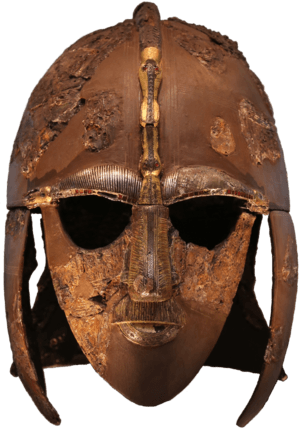Edith Pretty facts for kids
Quick facts for kids
Edith Pretty
|
|
|---|---|
| Born |
Edith May Dempster
1 August 1883 Elland, Calderdale, West Riding of Yorkshire, England
|
| Died | 17 December 1942 (aged 59) |
| Occupation | Landowner, benefactor, magistrate |
| Spouse(s) |
Frank Pretty
(m. 1926; died 1934) |
| Children | Robert Dempster Pretty |
| Parent(s) |
|
Edith May Pretty (born August 1, 1883 – died December 17, 1942) was an English woman who owned a large piece of land. On her property, one of the most amazing archaeological discoveries in history was made: the Sutton Hoo ship burial. She hired a local expert, Basil Brown, to explore the mysterious mounds on her land.
Contents
Who Was Edith Pretty?
Edith Pretty was a kind and generous person. She was also a landowner, which means she owned a lot of property. She is most famous for her role in the discovery of the Sutton Hoo treasures. This incredible find helped us learn more about ancient Anglo-Saxon kings.
Her Early Years
Edith Pretty was born in Elland, Yorkshire, England, in 1883. Her parents were Elizabeth and Robert Dempster. She had an older sister named Elizabeth.
A Family of Inventors
The Dempster family was very wealthy. They made their money by manufacturing equipment for the gas industry. Edith's grandfather, also named Robert Dempster, started the family business in 1855. Her father and uncle later started their own engineering company in Manchester.
Traveling the World
Edith's family loved to travel. They visited many countries, including Egypt, Greece, and Austria-Hungary. After finishing school, Edith spent six months in Paris in 1901. Later that year, her family went on a trip around the world. They saw places like British India and the United States.
From 1907 to 1925, Edith's family lived in a grand country house called Vale Royal Abbey. They had many staff members, including 25 people working inside the house and 18 gardeners. Edith also spent time helping with public and charity projects.
Life as an Adult
Edith Pretty dedicated much of her life to helping others and her community. She was a strong, independent woman who made a big impact.
Helping During Wartime
During the First World War, Edith helped at a Red Cross hospital in Winsford. She also helped find homes for people who had to leave their countries because of the war. By 1917, she was working with the French Red Cross in France.
After her mother passed away in 1919, Edith took care of her father. When he died in 1925, Edith and her sister inherited a huge amount of money. It was worth more than £500,000, which would be around £39 million today.
Marriage and Family
In 1926, Edith married Frank Pretty. He had first asked her to marry him when she was 18. Frank was a soldier who had served in the First World War. He was wounded twice during the fighting. After the war, he continued to serve in the army and also worked in his family's business.
Edith and Frank had a son named Robert Dempster Pretty, who was born in 1930. Sadly, Frank died in 1934 from stomach cancer.
A New Home at Sutton Hoo
After she got married, Edith bought a large estate called Sutton Hoo. It was located near the River Deben in Woodbridge, Suffolk. She also became a magistrate in Woodbridge. This meant she helped make decisions in local courts.
The Sutton Hoo Discovery
Edith Pretty's interest in history led to one of the most important archaeological finds ever. She had learned about archaeological digs from her travels. Her friend's uncle was an Egyptologist, someone who studies ancient Egypt.
Finding Ancient Treasures
There were about 18 ancient burial mounds on the Sutton Hoo estate. They were not far from Edith's home. In 1937, Edith talked to a local archaeologist named Vincent B. Redstone. She wanted to know if anything was hidden beneath the mounds.
Later, Basil Brown, a self-taught archaeologist, was invited to start digging. He began his work in 1938. In the summer of 1939, he made an incredible discovery. He found the remains of a huge ship burial! This ship may have been the final resting place of King Rædwald, an Anglo-Saxon king from the 7th century. Experts at the British Museum called it "one of the most important archaeological discoveries of all time."

A Gift to the Nation
After the discovery, a special investigation decided that the treasures found in the ship belonged to Edith Pretty. However, she decided to do something amazing. She donated all the treasures to the British Museum. This generous gift meant that everyone could see and learn from these ancient artifacts. The Prime Minister, Winston Churchill, offered her a special honor, but she politely declined.
Edith Pretty's Legacy
Edith Pretty passed away on December 17, 1942, at the age of 59. She was buried in the churchyard at Sutton. A painting of Edith was later given to the National Trust by her grandson.
Most of her money was put into a trust for her son, Robert. His aunt Elizabeth took care of him. Robert later became a farmer and passed away in 1988. The Sutton Hoo estate was eventually given to the National Trust. Today, the National Trust manages the site, allowing visitors to explore this historic place and learn about its incredible past.
See also
 In Spanish: Edith Pretty para niños
In Spanish: Edith Pretty para niños

